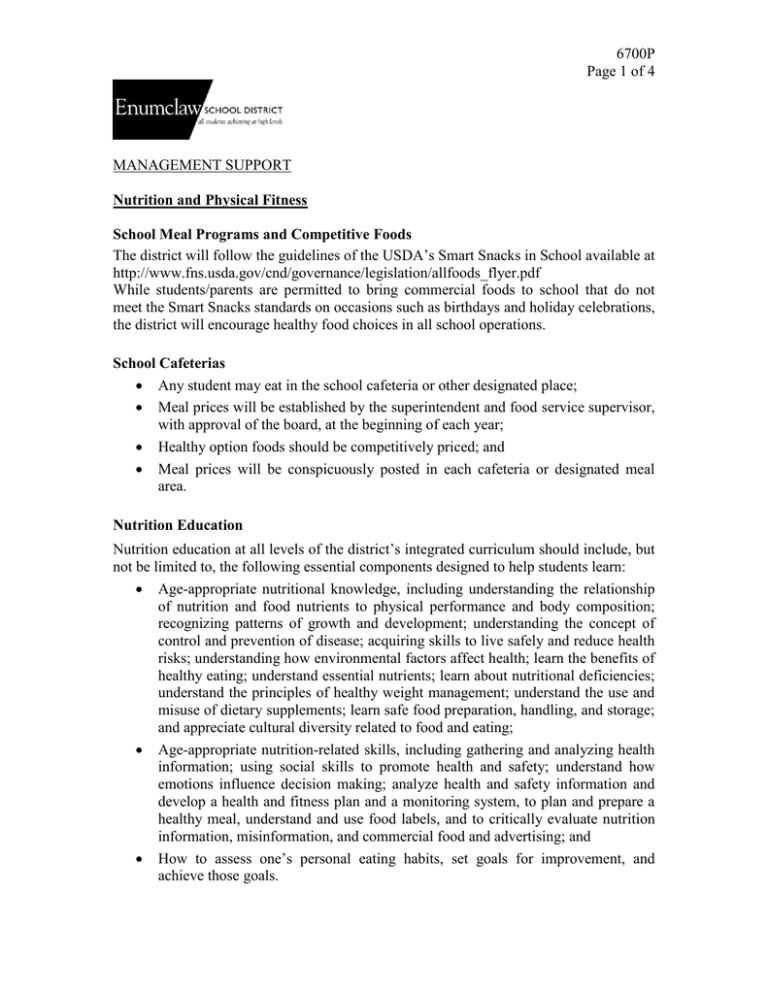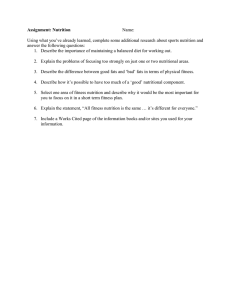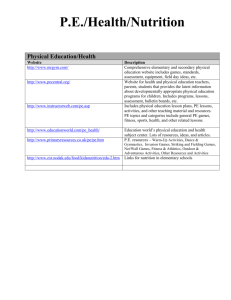6700P Page 1 of 4 MANAGEMENT SUPPORT
advertisement

6700P Page 1 of 4 MANAGEMENT SUPPORT Nutrition and Physical Fitness School Meal Programs and Competitive Foods The district will follow the guidelines of the USDA’s Smart Snacks in School available at http://www.fns.usda.gov/cnd/governance/legislation/allfoods_flyer.pdf While students/parents are permitted to bring commercial foods to school that do not meet the Smart Snacks standards on occasions such as birthdays and holiday celebrations, the district will encourage healthy food choices in all school operations. School Cafeterias Any student may eat in the school cafeteria or other designated place; Meal prices will be established by the superintendent and food service supervisor, with approval of the board, at the beginning of each year; Healthy option foods should be competitively priced; and Meal prices will be conspicuously posted in each cafeteria or designated meal area. Nutrition Education Nutrition education at all levels of the district’s integrated curriculum should include, but not be limited to, the following essential components designed to help students learn: Age-appropriate nutritional knowledge, including understanding the relationship of nutrition and food nutrients to physical performance and body composition; recognizing patterns of growth and development; understanding the concept of control and prevention of disease; acquiring skills to live safely and reduce health risks; understanding how environmental factors affect health; learn the benefits of healthy eating; understand essential nutrients; learn about nutritional deficiencies; understand the principles of healthy weight management; understand the use and misuse of dietary supplements; learn safe food preparation, handling, and storage; and appreciate cultural diversity related to food and eating; Age-appropriate nutrition-related skills, including gathering and analyzing health information; using social skills to promote health and safety; understand how emotions influence decision making; analyze health and safety information and develop a health and fitness plan and a monitoring system, to plan and prepare a healthy meal, understand and use food labels, and to critically evaluate nutrition information, misinformation, and commercial food and advertising; and How to assess one’s personal eating habits, set goals for improvement, and achieve those goals. 6700P Page 2 of 4 Nutrition and Food Services Operation In order to support the school’s nutrition and food services operation as an essential partner in the educational mission of the district and its role in the district’s comprehensive nutrition program, the superintendent is responsible for: Encouraging students to participate in the school’s breakfast meal program; Providing varied and nutritious food choices consistent with the applicable school meal program guidelines; and Providing that: o students have adequate time to eat their entire meal; o seating for meals is uncrowded and occurs in a pleasant and safe environment; o rules for mealtime behavior are consistently enforced; o mealtime supervision is appropriate; o elementary student recess held in conjunction with the lunch period occurs prior to, not immediately following, the lunch period. Staff Development Ongoing in-service and professional development training opportunities for staff in the area of food nutrition will be encouraged. Family and Community Involvement In order to promote family and community involvement in supporting and reinforcing nutrition education in the schools, the school principal is responsible for ensuring: Nutrition education materials and meal menus are made available to parents; Parents are encouraged to promote their child’s participation in the school meals program. If their children do not participate in the school meal program, parents should provide their children with healthy snacks/meals; Families are invited to attend exhibitions of student nutrition projects or health fairs; Nutrition education curriculum includes homework that students can do with their families (e.g., reading and interpreting food labels, reading nutrition-related newsletters, preparing healthy recipes, etc); School staff are encouraged to cooperate with other agencies and community groups to provide opportunities for student projects related to nutrition, as appropriate; and School staff consider the various cultural preferences in development of nutrition education programs and food options. Physical Education Health and Fitness It is the district’s position that all students have equal and equitable opportunities for physical activity and fitness education in our schools. The superintendent is encouraged 6700P Page 3 of 4 to review and consider implementing physical activity and fitness education program improvements. The goals of the district are: All children, from kindergarten through grade 12, will participate in a daily, quality, standards-based physical activity/fitness education program; All schools will have certificated physical education teachers providing instruction; and All schools will have appropriate class sizes, facilities, equipment, and supplies needed to deliver quality physical education consistent with national standards. Schools will require students in grades one through eight to engage in physical education averaging 100 instructional minutes per week and all high school students will complete two credit(s) of health and fitness. Access to school sites will be provided through permitting use of facilities to community youth sports groups consistent with the district’s facilities use policy, community college and municipal joint use agreements and partnerships with youth organizations so additional opportunities are available for all youth in our communities to participate in quality physical activity, fitness, sports and recreation programs. Schools should identify safe and active routes to school and promote alternative methods for children to travel to and from school, such as walking and bicycle programs. Schools will prohibit the use of physical activity and withholding of physical education class and other forms of physical activity as punishment. Family and Community Involvement In order to promote family and community involvement in supporting and reinforcing physical education in the schools, the school principal is responsible for ensuring: Physical education activity ideas are sent home with students; Parents are encouraged to promote their child’s participation in the school’s physical education programs and after school activities; Families are invited to attend and participate in physical education activity programs and health fairs; Physical education curriculum includes homework that students can do with their families; School staff consider the various cultural preferences in development of physical education programs; and School staff are encouraged to cooperate with other agencies and community groups to provide opportunities for students to participate in physical activity programs. Local School Wellness Policy (LSWP) The District will convene an advisory committee to assist in development of the district wide LWSP. The committee will include food service directors and staff, parents, building level administrators, school board members, students, nutritionists, school health care professionals, physical education staff, the public and interested community organizations. 6700P Page 4 of 4 Program Evaluation and Assessment Nutrition: The Food Services Coordinator will periodically measure, using the Wellness School Assessment Tool: 1) the extent to which all district schools are in compliance with the district’s LWSP; and 2) the extent to which the district’s LWSP compares to the Wellness School Assessment Tool itself. The Director of Business and Operations will annually describe, in the district’s Annual Report, the progress made in attaining the goals of the district’s LWSP. Physical Education: District physical activity/health and fitness programs will be monitored and assessed regularly in conjunction with other district academic and health-related programs using tools like the Physical Best Program, Healthy Kids Survey, CDC School Health Index or an OSPI approved assessment. Results of these surveys and assessments will be reported to the board, school sites, and made available to parents and community on an annual basis. Adopted: April, 2014



